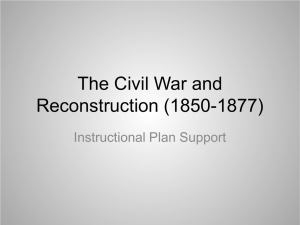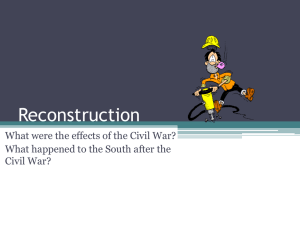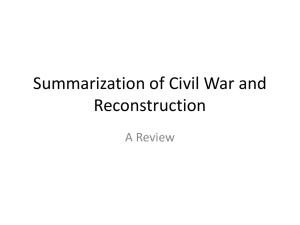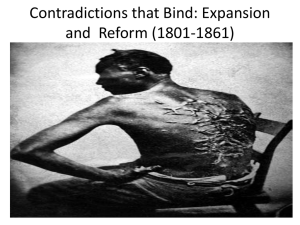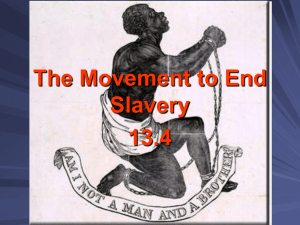ch 4 amer - Fullerton Union High School
advertisement
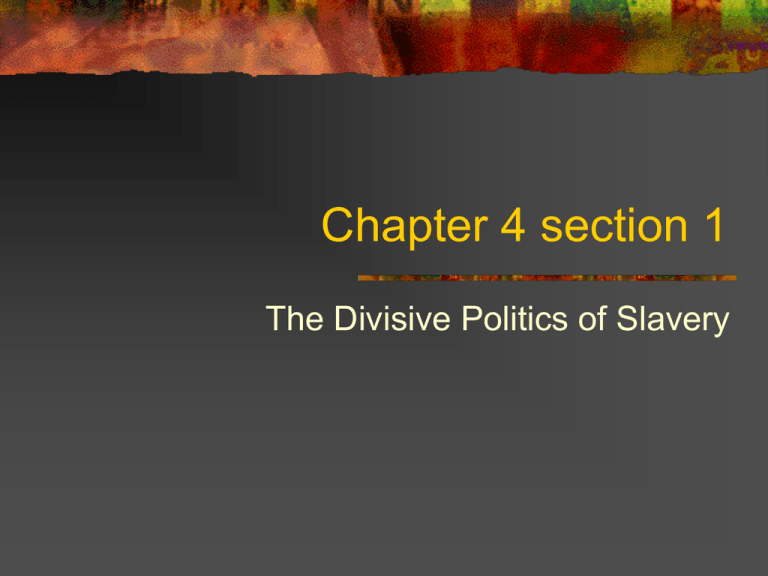
Chapter 4 section 1 The Divisive Politics of Slavery Terms and Names Secession Popular sovereignty Underground railroad Confederacy Harriet Tubman Harriet Beecher Stowe Franklin Pierce Dred Scott Abraham Lincoln Jefferson Davis Differences/Slavery North Growth of Industry Opposed slavery South Plantation Economy Dependent upon slavery Seccession? 1849-California asks to enter the Union Southerners are angry Most of California is south of Missouri Compromise line Believed that any ban on slavery was attack on their lifestyle Threatened to secede Compromise of 1850 Presented by Henry Clay California a free state (pleased the North) Fugitive Slave Act (pleased the South) Compromise of 1850 Proposed by Henry Clay California free state Fugitive Slave Act Required Northerners to return fugitive or escaped slaves to their masters Slaves were considered property not human Compromise also called for popular sovereignty in the New Mexico and Utah territories Compromise failed in Congress Sen. Stephen Douglas took up the leadership Managed to get Compromise passed Protest-Resistance-Violence Fugitive Slave Act provided harsh punishment for escaped slaves Also, for anyone who helped them Many Northerners were angry with this Compromise Free African Americans and abolitionist set up he Underground Railroad Secret network of volunteers Hid fugitive slaves on their dangerous journey north to freedom Harriet Tubman (an escaped Salve) famous “conductor” or worker on Underground Railroad Harriet Beecher Stowe-wrote Uncle Tom’s Cabin Popular book-helped North see the fight to ban slavery as a moral struggle Told of slavery horrors South saw it as an attack on their way of life Protest-Resistance-Violence 1854-Slavery in the territories became an issue again The Kansas-Nebraska Act Split Nebraska into the territories of Nebraska and Kansas Both could decide the slavery issue on their own Proslavery and antislavery people rushed into Kansas Each side wanted to have enough people in the territory to decide the vote on slavery Violence erupts from both sides Territory becomes known as “Bleeding Kansas” New Political Parties Whig Party split over the issue of slavery Split left it easy for Democrat Franklin Pierce to be elected (1852) president New parties appeared in the North Free-Soil Party Free-Soil Party The Know-Nothing Party Against slavery into the new territories Was not abolitionist Feared slave labor competing with wage labor system Know-Nothing Party Supported nativism Was against immigration New Political Parties 1854-Republican Party formed Brought together Free-Soilers, anti-slavery Whigs, Democrats, and nativists Election of 1856 Republican candidate-John C. Fremont Democratic candidate-James Buchanan Buchanan Wins! Conflicts Lead to Succession Dred Scott Decision Lincoln’s Election Harper’s Ferry Tariffs Dred Scott Decision Dred Scott-Slave taken by master into free states Scott claimed that being in a free state made him free Owner said that Scott was still a slave Case went to Supreme Court Ruled that slaves were property protected by the Constitution Southerners believed that this decision allowed slavery to be extended into the territories Lincoln-Douglas Debates 1858-Stephen Douglas ran for re-election to the Senate in Illinois Republican-Abraham Lincoln ran against him Held a series of debates about slavery in territories Douglas Lincoln Against slavery Favored popular sovereignty Called slavery “a vast moral evil” Douglas won the election Debates made Lincoln famous Harper’s Ferry 1859-Northern white abolitionist tried to start a slave rebellion John Brown and a group of followers attacked a federal arsenal in Harper’s Ferry, Virginia They were captured and and executed Northerners praised Brown Southerners were furious The Last Straw 1860-Republicans nominated Lincoln for president Democratic party split into Northern and Southern branches Lincoln win with no electoral votes from the South The South reacts dramatically December 1860-South Carolina seceded from Union Southerners believed they had lost political power in US Feared an end to their way of life By Feb. 1861-seven Southern states had seceded Formed the Confederate States of America-Confederacy Elected Jefferson Davis president Chapter 4, Section 4 Vocabulary Freedman’s Bureau Reconstruction Radical Republicans Andrew Johnson 14th Amendment 15th Amendment Scalawag Carpetbagger Hiram Revels Sharecropping Ku Klux Klan (KKK) Reconstruction & Its Effects Reconstruction Process of bringing Southern states back into the Union The Freedman’s Bureau was established by Congress Lasted from 1865-1877 Lincoln made a plan for Reconstruction Lenient or easy on the South Pardoned the South if it swore allegiance to the Union Radical Republicans were outraged at Lincoln’s plan After Lincoln died, Andrew Johnson’s plan was similar to Lincoln’s plan Radical Reconstruction Radical Republicans Wanted to destroy the political power of the former slave owners They wanted African Americans to be citizens Wanted African Americans to be able to vote Thought other plans were to lenient Congress Republicans in Congress controlled Reconstruction Passed law creating Freedman’s Bureau Gave food, clothing to former slaves Set up hospitals & schools Passed Civil Rights Act of 1866 States couldn’t enact laws that discriminated against African Americans Congress Passed the 14th Amendment Passed Reconstruction Act of 1867 Johnson asked Southerners not to support it because they had no say so in it! No State could enter the Union until it approved the 14th Amendment and gave the vote to black males Fight brewed between Congress and Johnson Congress looked for a way to impeach the president Said Johnson removed a cabinet member illegally Johnson was impeached Avoided conviction and removal of office by one vote in the Senate Congress 1868-Ulysses S Grant becomes president The black vote in the South helped him win 1870-15th Amendment is ratified Fifteenth Amendment Reconstructing Society By 1870-All former Confederate states were back in the Union Economics in the South were terrible Many men had died in the war People lost investments Farms were ruined State governments began public works programs to repair physical damage Provided social services They raised taxes to pay for these programs Different Goals 3 groups of Republicans had different goals for the South Scalawags Carpetbaggers Northerners who had moved South Tried to take advantage of Southerners African Americans Southern whites Small farmers Didn’t want wealthy planters to regain power Had voting rights for the first time-voted Republican Many Southerners resisted equality for African Americans Former Slaves During Reconstruction many former slaves moved to the cities They organized churches and schools Many voted & some were elected to office Hiram Revels first African-American senator Many wanted to farm their own land Had been promised “40 acres and a mule” by Sherman Congress did not honor this promise Southern Planters Southern elite wanted to return to the plantation system Tried to make sure former slaves couldn’t own land Many slaves turned to sharecropping Some became tenant farmers Allowed whites to control the labor of African Americans Rent land from landowners for cash Collapse of Reconstruction Southern whites didn’t like blacks voting Secret groups formed (KKK) that used violence to keep blacks from voting Whites refused to hire blacks Congress passed the Enforcement Acts to stop the violence Congress also gave the vote to many former Confederates Democrats began to regain power! Collapse of Reconstruction Reconstruction was weakened by a division in the Republican Party Bank failures known as the panic of 1873-led to a fiveyear depression Election of 1876 The disputed election resulted in the end of Reconstruction Southern Democrats agreed to accept Republican Rutherford B Hayes as president In return, federal troops would withdraw from the South Without federal troops, Southern democrats took control of the South Reconstruction was over!
